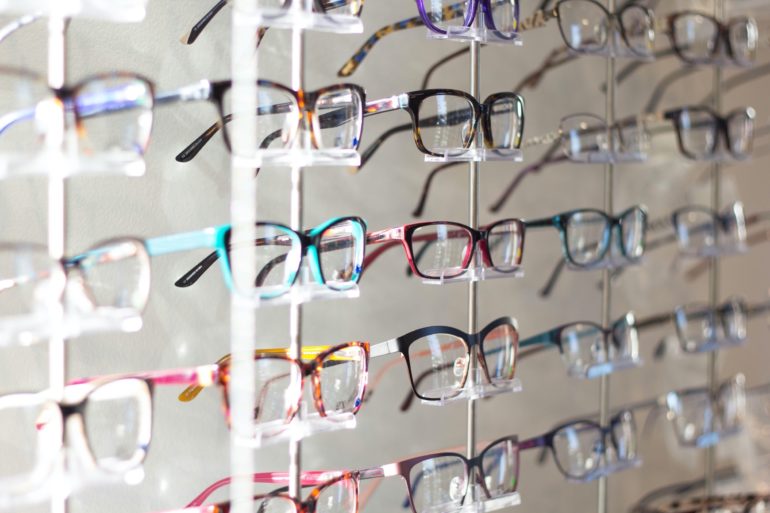I remember when I first had to wear glasses. I was about five years old. The frames were the kind that went up at the corners and had little ribbon-like designs engraved at the tips. Of course I was teased – “four eyes” was the most common taunt. Nowadays, it seems that more and more adults, and children, wear glasses. As norms change, perhaps it will be those who are not wearing glasses who will feel left out.
When it comes to eye care, children as young as a year and no older than three, should be examined annually. This is especially important if there is a history of poor vision or eye disease. With children, it is generally recommended that they be seen by an Opthalmologist. Such a Doctor has chosen to specialize in working with eyes. With these credentials, he or she is able to perform surgery as well as conduct routine eye examinations which include looking beyond vision to the overall health of the eye.
An optometrist is trained as a refractionist. In other words, he or she can also perform routine eye examinations, as well as recognize certain pathology. At such time, the Optometrist would refer to an Opthalmologist for consultation and possible intervention.
An Optician is trained to fill prescriptions, as determined by an Optometrist or Opthalmologist. Much like the pharmacist dispensing medication, a trained and skilled Optician should be acutely familiar with different styles and types of frames and lenses. He or she should be able to assist you in selecting the best possible combination and in fitting them well.
Perry Steigner, Optician at Medical Arts Optical, Sheppard and Leslie in North York, says that people who wear glasses are not nearly as stigmatized – other than in the literal sense – than they used to be. He even consults with adults who have no visual impairment, who wish to wear glasses with non-prescription lenses, in an effort to appear more intellectual, mature or business like.
Of course, where children are concerned, glasses are fitted for therapeutic reasons only. Steigner has fitted children as young as six months. After fifteen years of practical experience, he exudes competence. Since many of his referrals come from opthmalmologists in the area, he is used to working not only with standard difficulties, but with clients with a diversity of challenges.
When selecting a frame for a young child or infant, he says that fit is most important. For example, he recommends robust hinges and spring, table-style temples for greater durabilty and fit. Of course, plastic or polycarbonate (bullet proof plastic) is always recommmended for children’s lenses so that they do not shatter when dropped and are lighter to wear. Steigner also recommends a scratch resistant coating or bonding, and a UV filter built into the lesnese to protect their eyes from the harmful effects of the sun.
Although Steigner works with people of all ages, he does not consider himself a pediatric specialist. He directed me to Paula Finbow, an Optician at Shorney’s Optical. Finbow operates out of the Hospital for Sick Children and after more than twenty years of fitting children with glasses, is considered a specialist in her field. She has fitted children as young as six days old. Her warmth, sense of humour and genuine love of her work, shines through. She concurs with Steigner and adds that she doesn’t expect any parent to be soley responsible for making a decision when it comes to eyewear. She feels that it her role to work with the parent in selecting the most appropriate fit, size and shape of the eyewear. “Oversized sweaters are cute, but glasses are not,” she says. Cosmetics are important to parents, but should not be of premium importance when selecting. Since children may not feel that they have much choice when it comes to picking size and shape suitable for their face, it is important, she says, to help them feel some sense of control by allowing them to pick colour.
Since children sometimes lack the co-ordination to take proper care of glasses and cannot be expected to shy away from rough and tumble activities, it is wise to expect that their glasses will need constant attention and re-alignment. Finbow requests that children under the age of two visit her every month or two, between aged two and three, every three months and so on. Parents can expect that as their children grow and their eyes change, so their prescription may need to be modified and that their eyewear may need to be changed. Under the age of six, Finbow says that children may need to have their eyewear changed once every year or so. Six and up, every two years or more.
Although parents need to be realistic in the way a child handles his eyewear, they can teach and have reasonable expectations. For example, children ( and adults) should remove their glasses with both hands and put into a glasscase when not in use. Finbow also stresses that parents wash their children’s glasses on a regular basis – not just once a day. I’ve always found dishwashing liquid to be most effective and she says that this is fine. Glasses cannot be overwashed, she says.
For more information on the proper selection of quality eyewear or hours of operation, call Paula Finbow at 416-597-0230 or Perry Steigner. Consult your Yellow Pages for an optical centre close to your home, but be careful to check out the optician’s credentials carefully, especially when fitting children.
Girls, under the age of nine, will almost invariably pick a pink or purple shade, says Finbow. Older boys like black. Boys of all ages stil like the tortoise shell or preppy look.
There is a book by Sandra Lee Stuart called “Why do I have to wear glasses?” It’s for children and available through your local library or bookstore.
